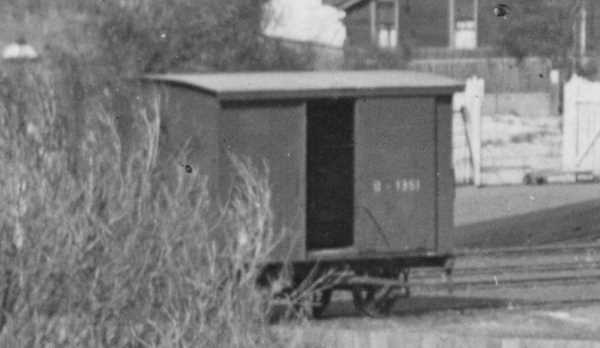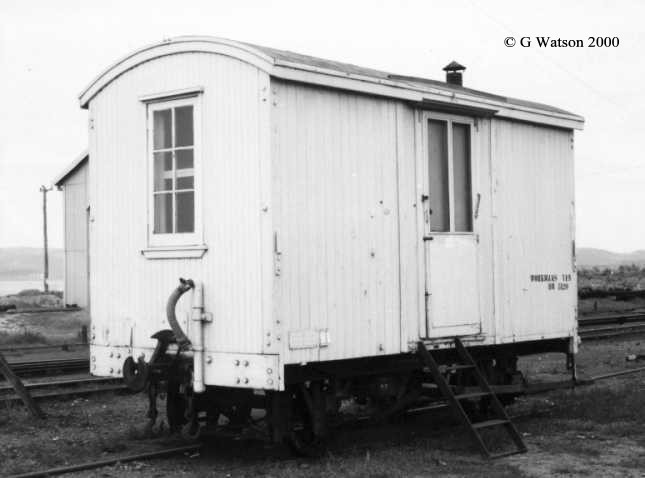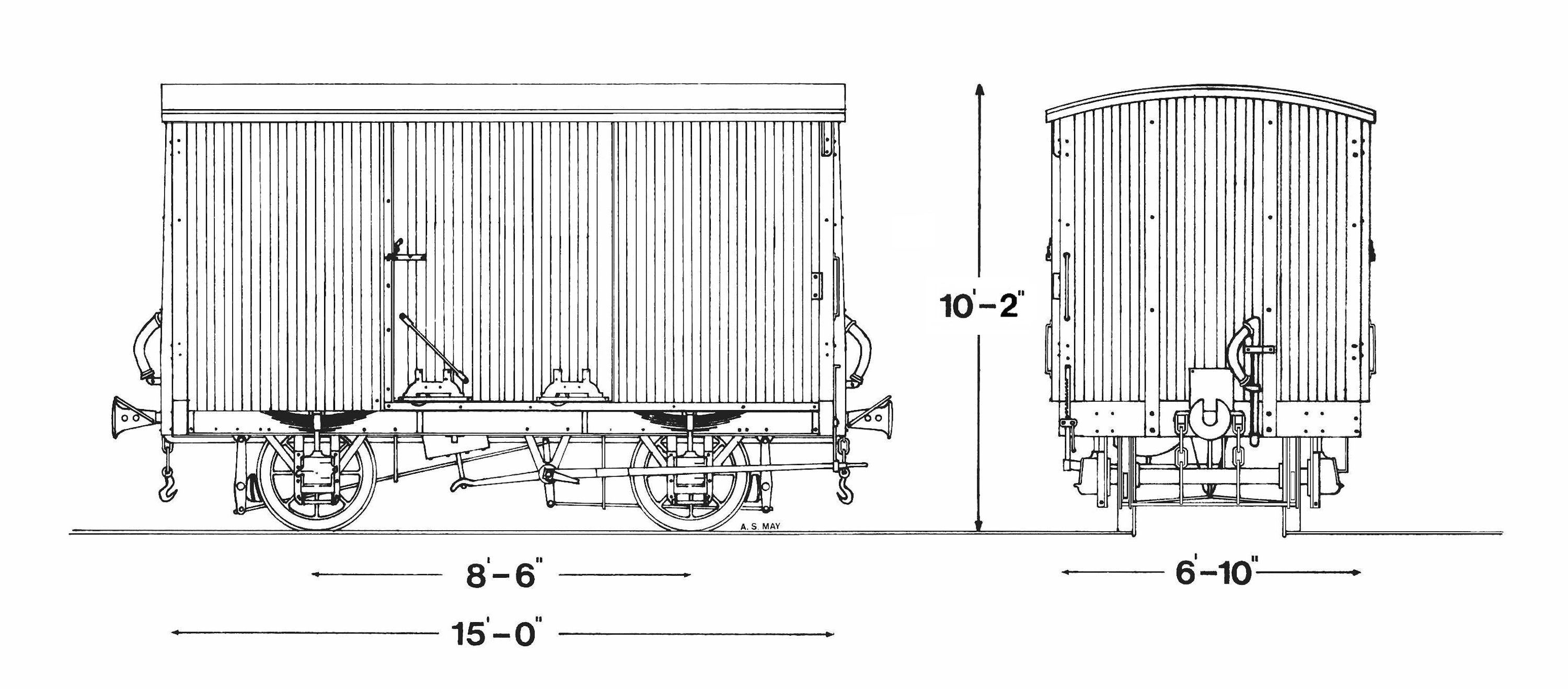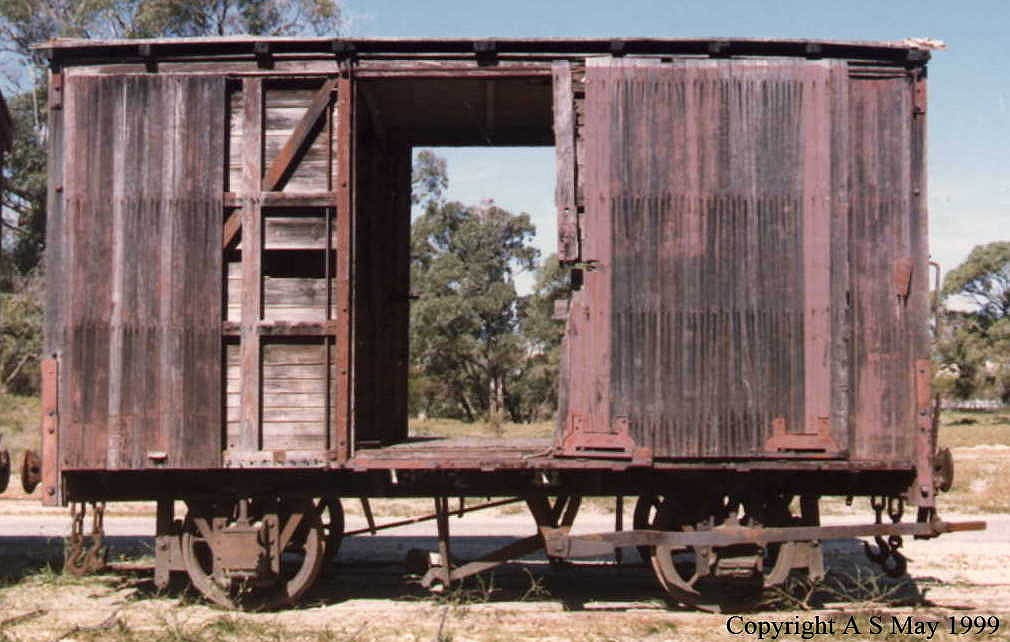| Class D NZR type vans (class G before 1900) |
|
This class consisted of 75 wagons built in 1894-1895 to a design which originated in New Zealand. They arrived in two batches. Bristol Wagon & Carriage Co built numbers 558-582 in 1894 and these were followed by 1178-1201 and 1329-1354 from Gloucester RCWCo in 1895. In 1896 six of these vans (574, 577, 581, 1178, 1188, 1348) were altered to E class cold storage vans. Numbers 560, 568 and 570 had all disappeared by 1900 and must either have been sold or destroyed in accidents. The WAGR outline diagram is shown below. |
A very battered old van (1343) at Woodman's point which had served as a DE class explosives van since 1957. |
|
|
|
In 1901 numbers 572, 1181, 1184, 1186, 1199, 1340, 1341 and 1351 were noted as to be used on express trains only. An image of D1351 from an old postcard of Meckering station (right) shows that the roof had been modified at an early date to over hang rather more than the standard van and this change could also apply to the other vans in this little group. In 1903 numbers 1180, 1183, 1345, 1353 were noted as being for use on mail trains. |
 |
| The record cards note that between 1909 and 1913 some of these vans were rebuilt (in what way is unknown). The vans involved were: | |
| 1909 | 565, 1196 rebuilt |
| 1910 | 562 rebuilt |
| 1912 | 559 rebuilt |
| 1913 | 1200 rebuilt |
| In 1914 number 575 became a DW class workmen's van but returned to class D in 1937 when 1335 was written off. In the same year 1341 was transferred to the WAGR saw-mill stock. In 1939 D558, which was on the Port Hedland railway, was converted into an H class lowsided wagon. ; D564 was the van used on the Hopetoun line and was written off when that line closed in 1943. There was then a steady decline in numbers as vans were written off: |
| 1914 | 575 to DW |
| 1937 | DW575 to D
1341 to WAGR saw mill 1335 to JETTY 504 |
| 1939 | 558 to H at Port Hedland
579 written off |
| 1940 | 1331 written off |
| 1943 | 564 written off at Hopetoun |
| 1948 | 1196 written off |
| 1949 | 565 written off |
| 1950 | 567, 1194 written off |
| 1951 | 1330 written off |
| However this decline was to some extent when a number of A class horseboxes on the NZR type underframe were converted to D class vans. These were 5116, 5119, 5120, 5121, 5126, 5128, 5129, 5130, 5132 in 1943 and 5115, 5117, 5136 in 1951. They differed slightly from the standard vans in having a higher roof. The WAGR outline diagram of the converted Horseboxes is shown below. |
 |
|
The photo at right from the RHWA collection shows former horsebox 5120 as a DW.
In 1953 there was a more drastic change when conversions into DW workmen's vans began.
|
 |
| However, another group of vans were re-bodied in the same year and given a new lease of life. These were 559, 566, 1181, 1184, 1185, 1189, 1191, 1198, 1334, 1336, 1340, 1344 and 1351 and 5119. Some if not all of these were new 16'-0" vans and 559 was one of those "rebuilt" earlier. The following year write-offs started again: |
| 1954 | 562, 582, 1182, 1329, 1333, 1346, 1349, 1353, 1354 written off |
| 1955 | 561, 569, 1199, 1200, 1338, 5128 written off |
| 1956 | 5129, 5136 written off |
| 1957 | 578, 1180, 1186, 1192, 1347, 5121 written off |
| 1958 | 571, 5119 written off |
| 1960 | 1179 written off |
| 1961 | 580 written off |
| 1962 | 576, 1337 written off |
| 1966 | 5115 written off |
| 1968 | 1344 written off |
| 1969 | 559, 1185, 1198, 1336 written off |
| 1970 | 1351 written off |
| 1972 | 1181, 1184, 1189 written off |
| 1977 | 1340 written off |
| The other fate for these vans was use as DE class explosives vans. Reclassifications to DE were as follows: |
| 1954 | 1183 to DE |
| 1957 | 1343, 5130 to DE |
| 1959 | 5117, 5126 to DE |
| 1961 | 580 to DE |
| 1964 | 1191 to DE |
| 1971 | 566, 1334 to DE |


